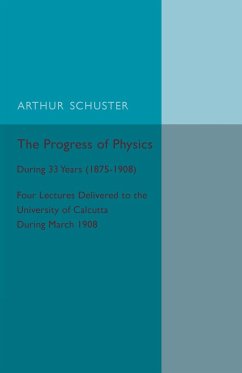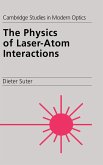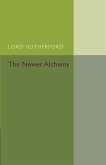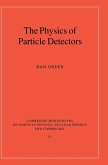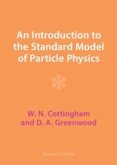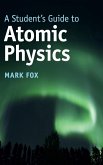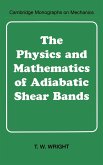Arthur Schuster
The Progress of Physics
Arthur Schuster
The Progress of Physics
- Broschiertes Buch
- Merkliste
- Auf die Merkliste
- Bewerten Bewerten
- Teilen
- Produkt teilen
- Produkterinnerung
- Produkterinnerung
Originally published in 1911, this book provides a concise discussion of advances in physics during the period 1875-1908.
Andere Kunden interessierten sich auch für
![The Physics of Laser-Atom Interactions The Physics of Laser-Atom Interactions]() Dieter SuterThe Physics of Laser-Atom Interactions202,99 €
Dieter SuterThe Physics of Laser-Atom Interactions202,99 €![The Newer Alchemy The Newer Alchemy]() Ernest RutherfordThe Newer Alchemy21,99 €
Ernest RutherfordThe Newer Alchemy21,99 €![The Physics of Particle Detectors The Physics of Particle Detectors]() Dan GreenThe Physics of Particle Detectors175,99 €
Dan GreenThe Physics of Particle Detectors175,99 €![An Introduction to the Standard Model of Particle Physics An Introduction to the Standard Model of Particle Physics]() W N CottinghamAn Introduction to the Standard Model of Particle Physics124,99 €
W N CottinghamAn Introduction to the Standard Model of Particle Physics124,99 €![A Student's Guide to Atomic Physics A Student's Guide to Atomic Physics]() Mark FoxA Student's Guide to Atomic Physics46,99 €
Mark FoxA Student's Guide to Atomic Physics46,99 €![The Adsorption of Gases on Solids The Adsorption of Gases on Solids]() A. R. MillerThe Adsorption of Gases on Solids35,99 €
A. R. MillerThe Adsorption of Gases on Solids35,99 €![The Physics and Mathematics of Adiabatic Shear Bands The Physics and Mathematics of Adiabatic Shear Bands]() T. W. WrightThe Physics and Mathematics of Adiabatic Shear Bands64,99 €
T. W. WrightThe Physics and Mathematics of Adiabatic Shear Bands64,99 €-
-
-
Originally published in 1911, this book provides a concise discussion of advances in physics during the period 1875-1908.
Hinweis: Dieser Artikel kann nur an eine deutsche Lieferadresse ausgeliefert werden.
Hinweis: Dieser Artikel kann nur an eine deutsche Lieferadresse ausgeliefert werden.
Produktdetails
- Produktdetails
- Verlag: Cambridge University Press
- Seitenzahl: 176
- Erscheinungstermin: 30. Juni 2015
- Englisch
- Abmessung: 216mm x 140mm x 10mm
- Gewicht: 230g
- ISBN-13: 9781107559905
- ISBN-10: 1107559901
- Artikelnr.: 43108730
- Herstellerkennzeichnung
- Libri GmbH
- Europaallee 1
- 36244 Bad Hersfeld
- gpsr@libri.de
- Verlag: Cambridge University Press
- Seitenzahl: 176
- Erscheinungstermin: 30. Juni 2015
- Englisch
- Abmessung: 216mm x 140mm x 10mm
- Gewicht: 230g
- ISBN-13: 9781107559905
- ISBN-10: 1107559901
- Artikelnr.: 43108730
- Herstellerkennzeichnung
- Libri GmbH
- Europaallee 1
- 36244 Bad Hersfeld
- gpsr@libri.de
Introduction; 1. Scope of lectures. State of physics in 1875. Science of
energy. Theory of gases. Elastic solid theory of light. Maxwell's theory of
electricity. Training of students. Maxwell's view. Accurate measurement and
discovery of Argon. German methods. Kirchhoff's laboratory. Wilhelm Weber's
laboratory. The two laboratories of Berlin. Laboratory instruction at
Manchester. Position of physics in mathematical tripos at Cambridge.
Todhunter's views. The Cavendish laboratory. Spectrum analysis. The
radiometer. Theory of vortex atom; 2. Action at a distance. Elastic solid
of theory of light. Maxwell's theory of electrical action. Electro-magnetic
theory. Verification of electromagnetic theory by Hertz. Electro-magnetic
waves. Wireless telegraphy. First suggestion of molecular structure of
electricity. Early experiments in the electric discharge through gases.
Kathode rays. Works of Goldstein and Crookes. Hittorf's investigations. Own
work on the discharge through gases. Ionization of gases. Magnetic
deflexion of kathode rays. J. J. Thomson's experiments. Measurement of
atomic charge; 3. Roentgen's discovery. Theories of Roentgen rays. Ionizing
power of Roentgen rays. Conduction of electricity through ionized gases.
Discovery of radio-activity. Discovery of radium. Magnetic deflexion of
rays emitted by radio-active bodies. Discovery of emanations. Theory of
radio-active change. Decay of the atom. Connexion between helium and the a
ray. Helium produced by radium. Strutt's researches on helium accumulated
in rocks. Electric inertia. Constitution of atom. J. J. Thomson's theory of
Roentgen radiation. The Michelson-Morley experiment. Principle of
relativity. The Zeeman effect. Other consequences of electron theory.
Contrast between old and modern school of physics; 4. Observational
sciences. Judgment affected by scale. Terrestrial magnetism. Existence of
potential. Separation of internal and external causes. Diurnal variation.
Magnetic storms. Their causes. Solar influence. Theories of secular
variation. Atmospheric electricity. Negative charge of Earth. Ionization of
air. Origin of atmospheric electricity. Electric charge of rain. Ebert's
theory. Cause of thunderstorms. The age of the Earth. Rigidity of Earth.
Displacement of axis. Gravitation. Identity of molecules of the same kind;
Index.
energy. Theory of gases. Elastic solid theory of light. Maxwell's theory of
electricity. Training of students. Maxwell's view. Accurate measurement and
discovery of Argon. German methods. Kirchhoff's laboratory. Wilhelm Weber's
laboratory. The two laboratories of Berlin. Laboratory instruction at
Manchester. Position of physics in mathematical tripos at Cambridge.
Todhunter's views. The Cavendish laboratory. Spectrum analysis. The
radiometer. Theory of vortex atom; 2. Action at a distance. Elastic solid
of theory of light. Maxwell's theory of electrical action. Electro-magnetic
theory. Verification of electromagnetic theory by Hertz. Electro-magnetic
waves. Wireless telegraphy. First suggestion of molecular structure of
electricity. Early experiments in the electric discharge through gases.
Kathode rays. Works of Goldstein and Crookes. Hittorf's investigations. Own
work on the discharge through gases. Ionization of gases. Magnetic
deflexion of kathode rays. J. J. Thomson's experiments. Measurement of
atomic charge; 3. Roentgen's discovery. Theories of Roentgen rays. Ionizing
power of Roentgen rays. Conduction of electricity through ionized gases.
Discovery of radio-activity. Discovery of radium. Magnetic deflexion of
rays emitted by radio-active bodies. Discovery of emanations. Theory of
radio-active change. Decay of the atom. Connexion between helium and the a
ray. Helium produced by radium. Strutt's researches on helium accumulated
in rocks. Electric inertia. Constitution of atom. J. J. Thomson's theory of
Roentgen radiation. The Michelson-Morley experiment. Principle of
relativity. The Zeeman effect. Other consequences of electron theory.
Contrast between old and modern school of physics; 4. Observational
sciences. Judgment affected by scale. Terrestrial magnetism. Existence of
potential. Separation of internal and external causes. Diurnal variation.
Magnetic storms. Their causes. Solar influence. Theories of secular
variation. Atmospheric electricity. Negative charge of Earth. Ionization of
air. Origin of atmospheric electricity. Electric charge of rain. Ebert's
theory. Cause of thunderstorms. The age of the Earth. Rigidity of Earth.
Displacement of axis. Gravitation. Identity of molecules of the same kind;
Index.
Introduction; 1. Scope of lectures. State of physics in 1875. Science of
energy. Theory of gases. Elastic solid theory of light. Maxwell's theory of
electricity. Training of students. Maxwell's view. Accurate measurement and
discovery of Argon. German methods. Kirchhoff's laboratory. Wilhelm Weber's
laboratory. The two laboratories of Berlin. Laboratory instruction at
Manchester. Position of physics in mathematical tripos at Cambridge.
Todhunter's views. The Cavendish laboratory. Spectrum analysis. The
radiometer. Theory of vortex atom; 2. Action at a distance. Elastic solid
of theory of light. Maxwell's theory of electrical action. Electro-magnetic
theory. Verification of electromagnetic theory by Hertz. Electro-magnetic
waves. Wireless telegraphy. First suggestion of molecular structure of
electricity. Early experiments in the electric discharge through gases.
Kathode rays. Works of Goldstein and Crookes. Hittorf's investigations. Own
work on the discharge through gases. Ionization of gases. Magnetic
deflexion of kathode rays. J. J. Thomson's experiments. Measurement of
atomic charge; 3. Roentgen's discovery. Theories of Roentgen rays. Ionizing
power of Roentgen rays. Conduction of electricity through ionized gases.
Discovery of radio-activity. Discovery of radium. Magnetic deflexion of
rays emitted by radio-active bodies. Discovery of emanations. Theory of
radio-active change. Decay of the atom. Connexion between helium and the a
ray. Helium produced by radium. Strutt's researches on helium accumulated
in rocks. Electric inertia. Constitution of atom. J. J. Thomson's theory of
Roentgen radiation. The Michelson-Morley experiment. Principle of
relativity. The Zeeman effect. Other consequences of electron theory.
Contrast between old and modern school of physics; 4. Observational
sciences. Judgment affected by scale. Terrestrial magnetism. Existence of
potential. Separation of internal and external causes. Diurnal variation.
Magnetic storms. Their causes. Solar influence. Theories of secular
variation. Atmospheric electricity. Negative charge of Earth. Ionization of
air. Origin of atmospheric electricity. Electric charge of rain. Ebert's
theory. Cause of thunderstorms. The age of the Earth. Rigidity of Earth.
Displacement of axis. Gravitation. Identity of molecules of the same kind;
Index.
energy. Theory of gases. Elastic solid theory of light. Maxwell's theory of
electricity. Training of students. Maxwell's view. Accurate measurement and
discovery of Argon. German methods. Kirchhoff's laboratory. Wilhelm Weber's
laboratory. The two laboratories of Berlin. Laboratory instruction at
Manchester. Position of physics in mathematical tripos at Cambridge.
Todhunter's views. The Cavendish laboratory. Spectrum analysis. The
radiometer. Theory of vortex atom; 2. Action at a distance. Elastic solid
of theory of light. Maxwell's theory of electrical action. Electro-magnetic
theory. Verification of electromagnetic theory by Hertz. Electro-magnetic
waves. Wireless telegraphy. First suggestion of molecular structure of
electricity. Early experiments in the electric discharge through gases.
Kathode rays. Works of Goldstein and Crookes. Hittorf's investigations. Own
work on the discharge through gases. Ionization of gases. Magnetic
deflexion of kathode rays. J. J. Thomson's experiments. Measurement of
atomic charge; 3. Roentgen's discovery. Theories of Roentgen rays. Ionizing
power of Roentgen rays. Conduction of electricity through ionized gases.
Discovery of radio-activity. Discovery of radium. Magnetic deflexion of
rays emitted by radio-active bodies. Discovery of emanations. Theory of
radio-active change. Decay of the atom. Connexion between helium and the a
ray. Helium produced by radium. Strutt's researches on helium accumulated
in rocks. Electric inertia. Constitution of atom. J. J. Thomson's theory of
Roentgen radiation. The Michelson-Morley experiment. Principle of
relativity. The Zeeman effect. Other consequences of electron theory.
Contrast between old and modern school of physics; 4. Observational
sciences. Judgment affected by scale. Terrestrial magnetism. Existence of
potential. Separation of internal and external causes. Diurnal variation.
Magnetic storms. Their causes. Solar influence. Theories of secular
variation. Atmospheric electricity. Negative charge of Earth. Ionization of
air. Origin of atmospheric electricity. Electric charge of rain. Ebert's
theory. Cause of thunderstorms. The age of the Earth. Rigidity of Earth.
Displacement of axis. Gravitation. Identity of molecules of the same kind;
Index.

